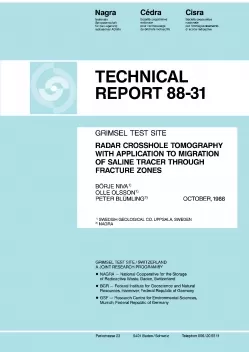
Technical Report NTB 88-31
Grimsel Test Site Radar crosshole tomography with application to migration of saline tracer through fracture zones
A comprehensive radar crosshole tomography survey has been carried out at the Grimsel Rock Laboratory in order to test the radar method with respect to its capability to describe geological features and to map migration of saline tracer through difference tomography. The radar survey has provided a map of the attenuation and slowness distribution of radar waves in a planar section with the dimensions 150 x 225 m. The program has included measurement points along parallel boreholes and a tunnel connecting these boreholes.
The slowness and attenuation tomograms give similar images of the structures at the investigated site. The largest anomalies are caused by lamprophyric dikes which are almost parallel to the boreholes while fracture zones give rise to anomalies of smaller magnitude. The attenuation tomograms have poorer resolution and contain more artefacts than the slowness tomograms. This is caused by systematic errors in the amplitude data caused by inadequate knowledge of the antenna radiation pattern for source points located in the tunnel.
The transport of saline tracer was investigated by making a tomographic inversion of the difference between data collected prior to injection of saline tracer and during injection. Two such experiments were performed with different injection points. The largest concentrations of tracer were observed close to the injection points. The tracer followed fracture zones extending from the injection points. The results clearly show the capabilities of the radar method to map tracer transport through fractured rock.
